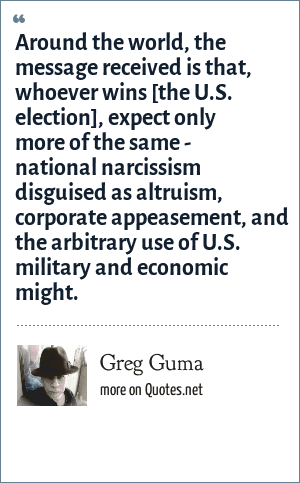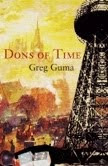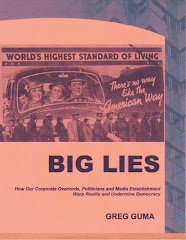Ten Years ago.... This week: War Zones – Afghanistan at the brink, the geopolitics of Mumbai, and the problem with pirates; Prospects for Single Payer, food stamps soar, and an obesity update. Music: Vinyl Resurgence and celebrating Odetta. Vermont: Gearing up for Gay Marriage, and Burlington’s Mayoral race. Plus, Drug News: Meth moves south and ending drug prohibition. Live Broadcast Friday, December 5, 2008, Noon EST, on The Howie Rose Show (WOMM), written and presented by Greg Guma, streamed on The Radiator.
AFGHANISTAN AT THE BRINK. The collapse of Afghanistan is closer than you think. Kandahar is in Taliban hands - all but a square mile at the center of the city - and the first Taliban checkpoints are scarcely 15 miles from Kabul. Hamid Karzai's corrupt government is almost as powerless as the Iraqi cabinet in Baghdad's "Green Zone." Lorry drivers carry business permits issued by the Taliban, which runs the courts in remote areas.
The Red Cross warns that humanitarian operations are being drastically curtailed. More than 4,000 people, at least a third of them civilians, have been killed in the past 11 months, along with NATO troops and about 30 aid workers. Both the Taliban and Karzai's government are executing their prisoners in greater numbers.
According to one Kabul business executive, nobody wants to see the Taliban back in power, but people hate the government and there's mass unemployment.
Afghans working for charitable groups and the UN are being pressured to give information to the Taliban and provide them with safe houses. In the countryside, farmers live in fear of both sides in the war. In short, seven years after 9/11 and the US overthrow of the Taliban we’re almost back to square one.
MUMBAI: WHAT’S AT STAKE. A virtually unknown group called "the Deccan Mujahideen" has claimed responsibility for the recent attacks in India. The Deccan Plateau refers to a region of central-Southern India. According to police sources, attackers who survived say they belong to Lashkar-e-Tayyiba, a Pakistani Kasmiri separatist organization covertly supported by Pakistani military intelligence, known as the ISI. Both Western and Indian media point at Pakistan and its alleged support of Islamic terrorist groups.
Here’s where it gets complicated. The ISI is a proxy of the CIA. Since the early 1980s, Pakistani intelligences has worked closely with its US and British intelligence counterparts. Thus, if the ISI was involved in a major covert operation directed against India, the CIA should have had prior knowledge about the nature and timing of the operation. The ISI isn’t known to act without the consent of its US intelligence counterpart.
Due to this connection, some analysts say that, whether or not US intelligence knew in advance, the US will use the Mumbai attacks to stir up divisions between Pakistan and India, justify US military actions inside Pakistan, and extend the "war on terrorism."
If you don’t buy that, there’s at least one other possibility. As a result of the attacks, Pakistan may relocate 100,000 troops currently at the Afghan border to the Indian border. If that happens, US operations on the border with Afghanistan will become more difficult, since it relies on Pakistani troops to assist with its border operations, and especially to protect the supply route for US operations. Who gains in this scenario: Al Qaeda.
Whoever knew or did what, what are the options? Bomb suspected terrorist cells in India? Send the Marines to Kashmir? Regime change in Pakistan? None or these would be very helpful. Yet the Bush administration pursued similar tactics against the Taliban in Afghanistan, Saddam Hussein in Iraq, and suspected terrorist hideouts in Pakistan. Heck of a job.
The Taliban is back in Afghanistan. Al-Qaeda, which didn't exist in Iraq before the invasion, has a foothold there now. And Pakistan, thanks to former dictator Pervez Musharraf and his intelligence agency, remains Terrorism Central.
Unfortunately, India may now go down the same road, staging its own war on terror. According to the Times of London, "The Indian government is now considering a range of responses, including suspending its five-year peace process with Pakistan, closing their border, stopping direct flights and sending troops to the frontier." It's one thing when the US squares off against the Taliban. But both India and Pakistan have nuclear weapons, so any "war on terror" between those two can go global at a moment's notice.
There is an alternative. Instead of using the military, for example, the British have largely relied on police work to track down and neutralize terrorists. Both the UN and Interpol focus on sharing information among police forces and shutting down the financing of terrorist networks. In other words, instead of fighting fire with fire, the flames could be doused with water. And the most effective fire extinguisher is still the rule of law.
PIRATE POLITICS. In the 18th century, Britain hung pirates in public. The idea was to make it look like not a very good career option. Now, three centuries later, pirates sail the high seas with near impunity – stealing, blackmailing and intimidating commercial ships. And it's not clear who can or should be the pirate police.
An international fleet of warships, including US, British, Danish, Italian, Greek, French and Canadian ships, is operating in the waters off Somalia. The International Maritime Bureau estimates 100 pirate attacks have occurred there this year.
Last week, for example, pirates tried to attack a US cruise ship, the MS Nautica, with over 1,000 people on board. The ship outran the pirates, but other ships haven’t been as lucky – like the Saudi oil tanker seized late last month with its crew and $100 million worth of oil.
Anyone can step up to battle the pirates. But bringing weapons on board ships is "strongly discouraged" by the UN International Maritime Organization, and experts say that arming commercial crews is a bad idea since it can lead to an international incident.
Since most crews don't carry weapons, ships resort to non-violent methods to ward off the pirates, including long-range acoustic devices that blast loud, irritating noises. Sounds wimpy, but it’s apparently the most annoying sound you've ever heard. It can actually make you nauseous. Other non-lethal methods include electric fences and hoses that spray pirates with water and knock them off their ladders before they can climb on board.
But non-violence isn't always effective. Last week, when pirates struck a chemical tanker in the Gulf of Aden, three guards from a British anti-lethal security company, Anti-Piracy Maritime Security Solutions, couldn’t fend off the pirates and eventually threw themselves overboard to avoid capture.
The UN Security Council has extended its authorization for countries to enter Somalia's territorial waters with advanced notice and to use "all necessary force" when combating piracy. The US security firm Blackwater, which operates in Iraq, announced in October that it was making its 183-foot ship, the McArthur, available to companies looking to hire security. Great movie concept. But as a foreign policy, not so much.
And still, even when the pirates can be defeated, there’s a problem. Nobody wants responsibility for the pirates, especially when they come from war-torn places like Somalia. Plus, if they hand the pirates over to the wrong country, they sometimes claim asylum. So far, the new pirates are apparently beating the system.
NATIONAL SCENE
WHAT ABOUT SINGLE PAYER? You might not know it, but in each of the last several sessions of Congress, Rep. John Conyers has introduced single payer health care legislation. The current bill is HR 676, the Conyers-Kucinich National Health Care Act, endorsed by dozens of city councils, state legislatures, county governments, and 90 members of Congress, including more than 30 members of the Congressional Black Caucus. Organizations like the Citizens Alliance for National Health Care are raising money to buy ads for a national media campaign. Yet, the bill has been virtually invisible in mainstream media.
While Barack Obama has promised "universal health care," he and his advisors have explicitly rejected single payer health care. During the campaign, he managed to avoid mention of it except for a few unscripted moments when asked in public. Instead, he and his team want to make government money available to buy private health care, and subsidize a new risk pool, most likely through private insurers, for people who can't find any affordable private coverage.
So, if single payer legislation doesn’t make it to the floor this time, the blame can clearly be laid at the feet of the new president and his party.
FOOD STAMPS SET A NEW RECORD. The US poised to set a new record in food stamp use, more than 30 million people. The previous record was set in 2005, after Hurricane Katrina displaced a million refugees from one of the poorest cities in the country. If all the eligible people were enrolled, another 10 million families might be getting them.
A dollar spent on food stamp benefits generates $1.73 of economic activity, according to economists. This multiplier affect beats even the impact of unemployment insurance. But the purchasing power of food stamps hasn’t kept pace with the inflation in food prices, currently 6.5 percent and expected to hit 8 percent by the end of the year.
TO LOSE WEIGHT, HOLD THE ADVERTISING. Want to cut national obesity? We could cut at least 18 percent of America’s fat just by banning fast-food advertising to children. That’s according to a new study by the National Bureau of Economic Research and National Institutes of Health. Not unexpectedly, the Center for Consumer Freedom, a front group for the restaurant and fast-food industry, calls the study "erroneous" because one of the authors admits that "a lot of people consume fast food in moderate amounts and it doesn't harm their health." But this doesn’t contradict the study's basic findings. Previous studies have reached similar conclusions.
MUSIC
VINYL RESURGENCE. Shipments of LPs jumped more than 36 percent from 2006 to 2007 to more than 1.3 million, according to the Recording Industry Association of America. During the same period shipments of CDs dropped more than 17 percent to 511 million, losing ground to digital formats. Based on the first three months of this year, Nielsen Sound Scan says vinyl album sales could reach 1.6 million in 2008.
The resurgence of vinyl centers on a long-standing debate over analog versus digital sound. Digital recordings capture samples of sound and place them very close together as a complete package that sounds nearly identical to continuous sound to most people. Analog recordings on most LPs are continuous, which supposedly produces a truer sound – though some new LP releases are being recorded and mixed digitally, then delivered analog.
But it's not just about the sound. Audiophiles say they also want the overall experience – the sensory experience of putting the needle on the record and lingering over the liner notes or large format extras.
"I don't think vinyl is for everyone; it's for the die-hard music consumer," said Jay Millar, director of marketing at United Record Pressing, a Nashville based company that is the nation's largest record pressing plant.
Independent music stores, the primary source of LPs in recent years, say many fans never left the medium. "People have been buying vinyl all along," says Cathy Hagen, manager at 2nd Avenue Records in Portland. "There was a fairly good supply from independent labels on vinyl all these years. As far as a resurgence, the major labels are just pressing more now."
Some of the new fans are baby boomers nostalgic for their youth. But to the surprise and delight of music executives, increasing numbers of the iPod generation are also purchasing turntables and vinyl records. Contemporary artists have begun issuing their new releases on vinyl in addition to CD and MP3 formats. As an extra lure, labels are including coupons for free audio downloads with their vinyl albums so that Generation Y music fans can get the best of both worlds: high-quality sound at home and iPod portability for the road.
While new records sell for about $14, used LPs go for as little as a penny or as much as $2,400 for a collectible, autographed copy. In October, Amazon.com introduced a vinyl-only store and increased its selection to 150,000 titles Its biggest sellers? Alternative rock, followed by classic rock.
VOICE OF A MOVEMENT. Odetta, the folk singer with the powerful voice who moved audiences and influenced fellow musicians for a half-century, died last week at 77 of kidney failure. In spite of failing health that restricted her to a wheelchair, Odetta performed 60 concerts in the last two years, singing for 90 minutes at a time.
With a booming, classically trained voice and spare guitar style, Odetta gave life to the songs by workingmen and slaves, farmers and miners, housewives and washerwomen, blacks and whites. First coming to prominence in the 1950s, she influenced Harry Belafonte, Bob Dylan, Joan Baez and other singers who had roots in the folk music boom. When she sang at the March on Washington in August 1963, "Odetta's great, full-throated voice carried almost to Capitol Hill," The New York Times wrote.
Among her notable early works were her 1956 album "Odetta Sings Ballads and Blues," with songs like "Muleskinner Blues" and "Jack O' Diamonds"; and her 1957 "At the Gate of Horn," featuring the popular spiritual "He's Got the Whole World in His Hands."
In a 1983 Washington Post interview, Odetta theorized that humans developed music and dance because of fear, "fear of God, fear that the sun would not come back, many things. I think it developed as a way of worship or to appease something. ... The world hasn't improved, and so there's always something to sing about."
"I'm not a real folksinger," she told The Post. "I don't mind people calling me that, but I'm a musical historian.”
VERMONT
GEARING UP FOR GAY MARRIAGE. Last week Windsor Senator John Campbell promised to reintroduce and push a gay marriage bill in 2009. Governor Douglas has reiterated his opposition, arguing that the debate will distract Vermont from other important issues. He declines to say whether he would veto a bill. Senate leaders have indicated that they aren’t sure whether this will be a priority, and some have questioned whether the Legislature can address our civil rights and deal with the economic challenges in the same session.
Here’s what Senator Campbell wrote in defense of the bill:
“Please rest assured, the civil rights of all Vermonters will be a central issue for me in the upcoming session, alongside the economy, the State's financial challenges, and other critical matters. Although I had hoped that the Governor would step up and share leadership on this important issue, I am not waiting for his advance approval on this. It's too important, and our job is to lead. There's no tension between eliminating discrimination in our laws and meeting the economic challenges we face. Our legislature works through committees, and always tackles dozens of important matters at once. With the foundation laid by the Vermont Commission on Family Recognition and Protection, on which I served, the Legislature should be able to address a marriage bill thoughtfully and efficiently. Plus, making Vermont a discrimination-free zone will help our economy by supporting our tourism industry and giving our businesses a competitive advantage.
“I realize that Vermont is ready to move forward. In my work on the Vermont Commission on Family Recognition and Protection I heard from hundreds of Vermonters whose lives are impacted in a real and significant way by our marriage law's exclusion of same-sex couples. It's time to take the next step. Together, I'm confident we can."
MAYORAL SWEEPSTAKES. The race for Burlington mayor got a little more crowded last week as Dan Smith, attorney for the Greater Burlington Industrial Corp. announced his candidacy as an indepedent. Smith is the son of former US Rep. Peter Smith and great grandson of a founder of Burlington Savings Bank. The other candidates are current Mayor Bob Kiss, a Progressive, and City Council member Andy Montroll, a Democrat. Republican Council President Kurt Wright is also likely to run.
DRUG NEWS
METH MOVES SOUTH. Drug violence, including decapitations and grenade attacks, has killed some 4,500 people in Mexico this year, but thousands of others are falling victim to a quieter crisis: addiction to methamphetamine. Mexico is now the largest producer of meth for the US market and traffickers are finding a growing number of users at home, many of them minors.
Meth use in Mexico has quadrupled in the last six years, according to a survey by their health ministry. As US authorities cracked down in recent years on the sale of the drug's ingredients, busting "mom and pop" labs in blue collar garages and bathrooms, Mexican gangs that already smuggled huge quantities of cocaine and marijuana into the US moved in to meet the demand for meth. They’re now churning out tons of meth in "super labs."
ENDING THE NEW PROHIBITION. Albert Einstein defined insanity as doing the same thing repeatedly and expecting different results. His definition perfectly fits the US war on drugs, a multi-billion dollar, four-decade exercise in futility.
This war has helped turn the US into the country with the world’s largest prison population. The US has 5 percent of the world’s population but around 25 percent of the world’s prisoners. Under the headline “The Failed War on Drugs,” Washington’s middle-of-the-road Brookings Institution said in a November report that drug use hasn’t declined significantly over the years and that “falling retail drug prices reflect the failure of efforts to reduce the supply of drugs.”
This brings us to Law Enforcement Against Prohibition (LEAP), an organization started in 2002 by police officers, judges, narcotics agents, prison wardens and others with first-hand experience of implementing policies that echo the prohibition of alcohol. Prohibition, widely regarded a dismal and costly failure of social engineering, came to an end 75 years ago this month.
As LEAP sees it, the best way to fight drug crime and violence is to legalize drugs and regulate them the same way alcohol and tobacco is now regulated. “We repealed prohibition once and we can do it again,” one of the group’s co-founders, Terry Nelson, told a Washington news conference on December 2. “We cannot arrest our way out of this problem.”
These advocates of drug legalization hope that the similarities between today’s economic crisis and the Great Depression will result in a more receptive audience for their pro-legalization arguments.
The budget impact of legalizing drugs would be enormous, according to a study prepared to coincide with the 75th anniversary of prohibition’s end. Harvard economist Jeffrey Miron estimates that legalizing drugs would inject $76.8 billion a year into the US economy — $44.1 billion through savings on law enforcement and at least $32.7 billion in tax revenues from regulated sales.
Miron published a similar study in 2005 looking only at the budgetary effect of legalizing marijuana. That study was endorsed by more than 500 economists, including Nobel laureates Milton Friedman of Stanford University, George Akerlof of the University of California and Vernon Smith of George Mason University.
“We urge…the country to commence an open and honest debate about marijuana prohibition,” the economists said in an open letter to President Bush, congress, governors and state legislators. “At a minimum, this debate will force advocates of current policy to show that prohibition has benefits sufficient to justify the cost to taxpayers, foregone tax revenues and numerous ancillary consequences that result from marijuana prohibition.”
ORIGINALLY POSTED ON DECEMBER 5, 2008


































